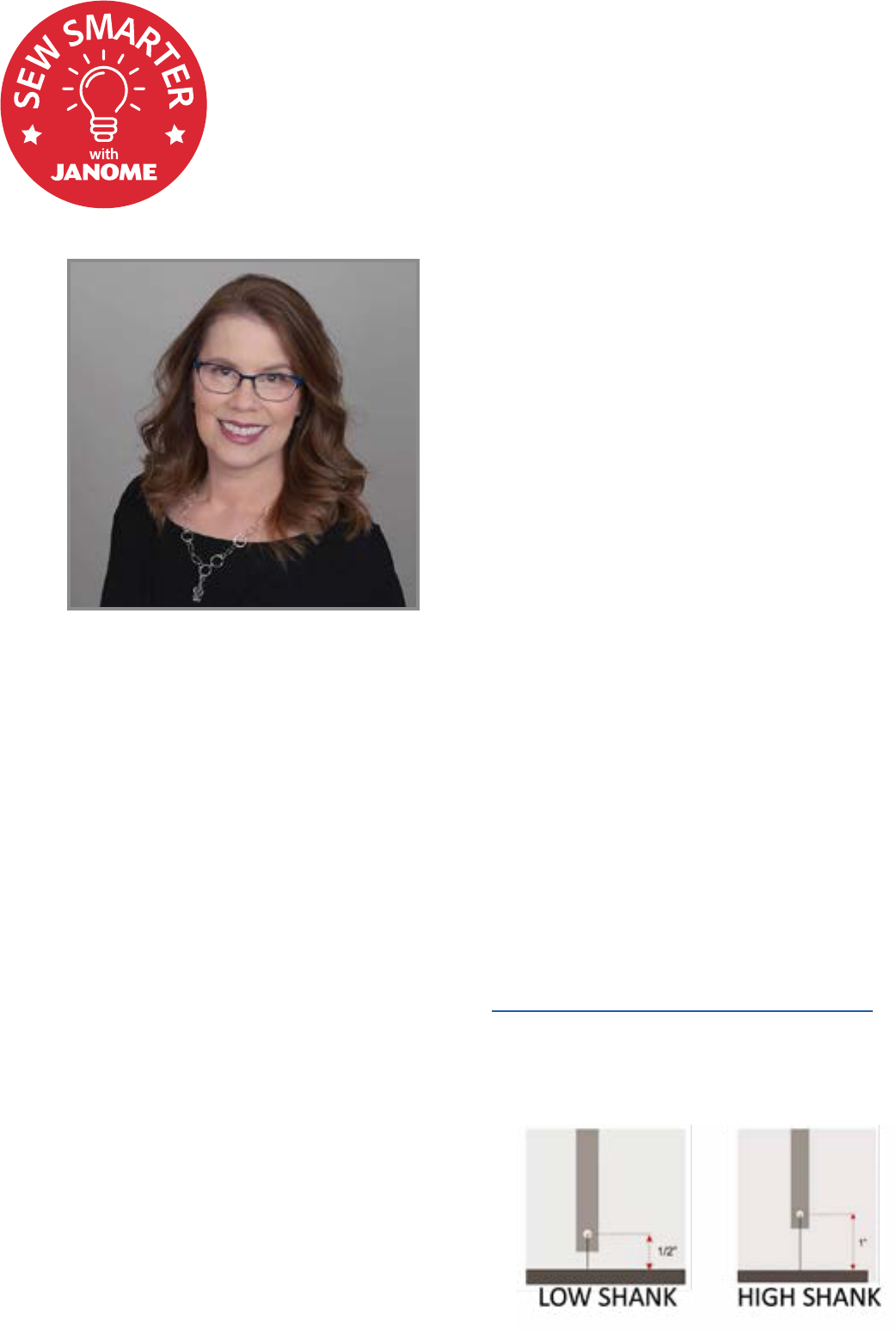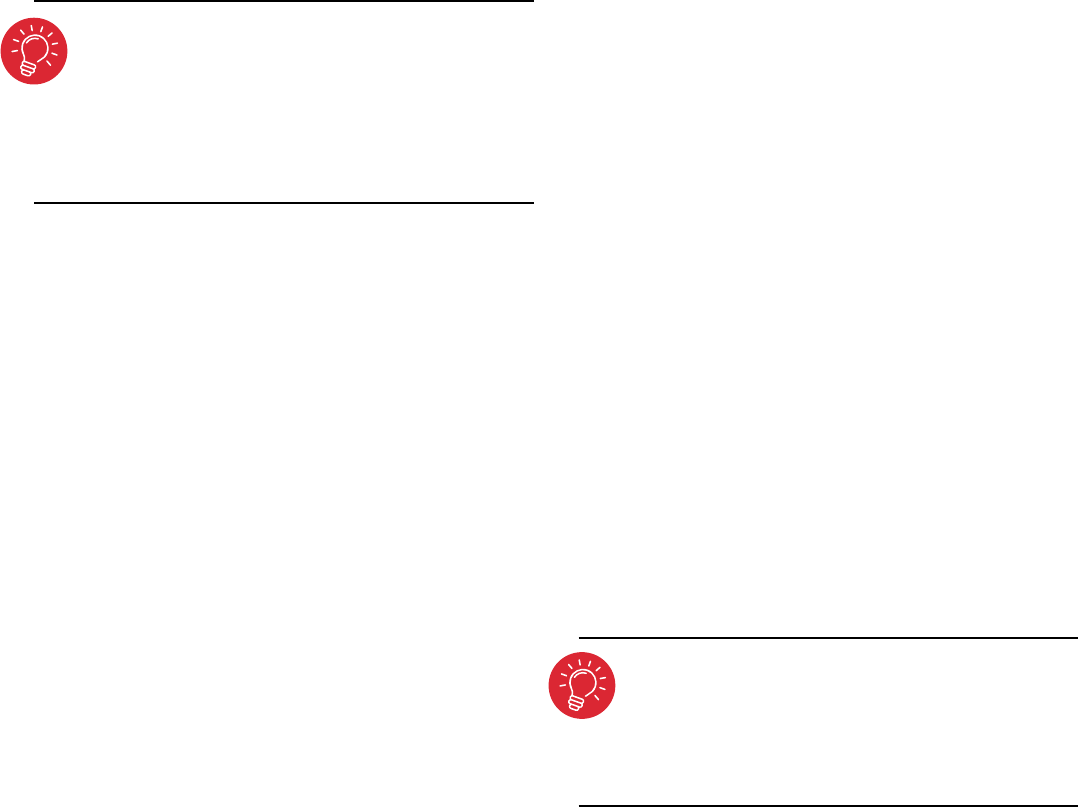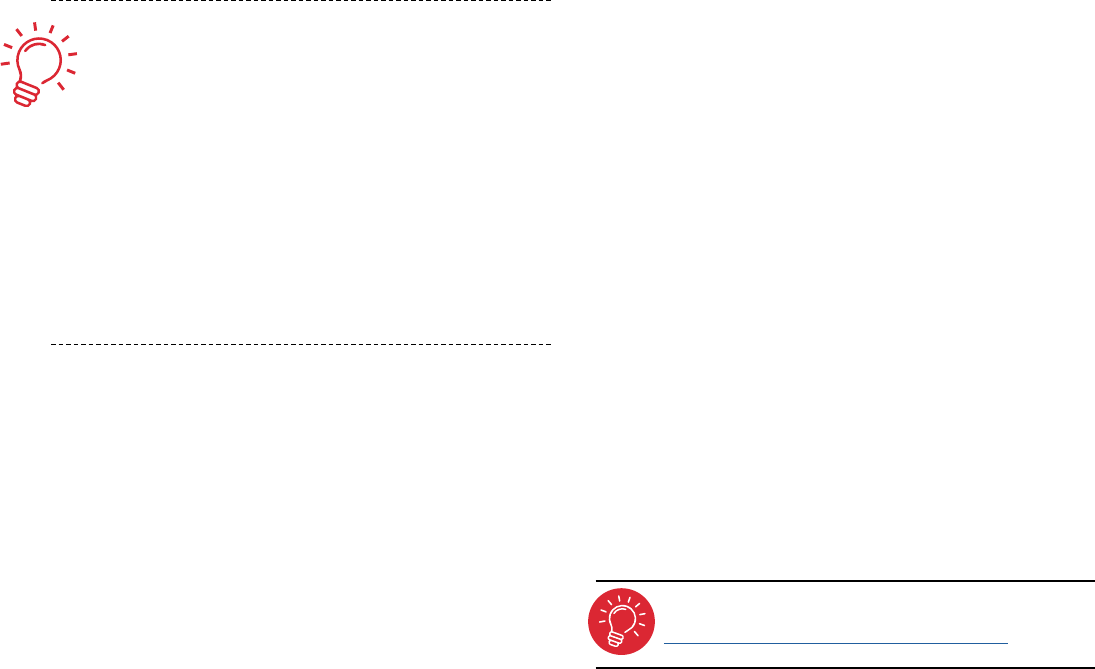
SEW SMARTER: RULERWORK
1
Rulerwork:
A Step-by-Step Journey into Guided-Motion Quilting
by Kate Quinn
Kate Quinn, Janome National Educator
Although Kate was already an experienced quilter
when she was introduced to rulerwork quilting in
2015, it quickly became her passion. Kate loves
sharing the skills and knowledge that she has
gained over the years to help students improve
their quilting and realize the benets of this of
this wonderful technique.
Optional Tools
• Westalee Spacing Gauge
• A Freemotion Glider
• Machine with a Needle Down and
LoweredFeed dogOption
• Machine withSpeed Control
• Knee Lift
• Quilting Gloves
Which Janome Ruler Foot do I need?
Domestic Machines
Most domestic machines are classied as either
LOW SHANK or HIGH SHANK. To determine your
shank size, lower your machine foot bar (without
foot) and measure the distance from the center
of the screw hole on the bar to the needle plate.
Machines that measure ½” are considered low
shank and high shank machines measure about
1”. An exception to this classication is Janome
straight stitch machines which required a special
rulerfoot for straight stitch only machines.
Longarm Machines
If you are working on a Janome Longarm, the
Janome EZ Rulerfoot is recommended for
template work along with a ruler base.
For more information on a selecting a rulerfoot
or other supporting tools, check your manual or
look up your machine on the Janome website:
Janome Machines - Search for your Machine.
Rulerfeet may be listed under standard or
optional accessories depending on your machine.
Your local dealer can also be a great source of
information.
Tools and Supplies for Rulerwork
Essential Tools
• ¼” Rulerfoot to t your machine (high or low
shank)
• At least one quilting template or ruler along
with Stable taper ruler grips.
• 40-wt polyester thread with matching top and
bobbin for beginners.
• Extension Table
• Janome Purple Needle or Size 90 Topstitch
Needles
• Comfortable Chair and or cushion – correct
height is very important for success.
• Quilt-safe Marking Tools

SEW SMARTER: RULERWORK
2
Other ruler feet brands may work on Janome
machines, but Janome feet oer easy adjustment of
the foot height without tools. Janome feet can be
adjusted manually or electronically. It is essential that the
foot “kiss” the fabric sandwich when doing rulerwork, so
this is a convenient feature of Janome rulerfeet.
Template Knowledge by Machine Shank
Style
Always attach Stable Tape or other suitable ruler
grip tape to the back of your template when
doing rulerwork. It helps the template and
fabric move together. Determine the best hand
position rst and then position the tape under
your ngertips for best results.
1. Low Shank Machines:
a. Low Shank Templates are 3mm in
thickness.
b. Low Shank machines have very low
clearance between the rulerfoot and the
bed of the machine. This lack of space
is especially noticeable at the rear of the
ruler foot. This is the reason for “Low
Shank” Templates. A thinner template ts
this narrow Low Shank space more easily,
so it works better on a low shank machine.
c. When using the Janome Convertible
Freemotion foot, a high shank template
will t behind the Janome Low Shank
rulerfoot, but other brand rulerfeet usually
do not have enough room for a High
Shank template, so Low Shank templates
are the best option for Low Shank
machines.
2. High Shank Machines:
a. High Shank Templates are 4.5mm in
thickness.
b. A High Shank rulerfoot does have great
clearance at the rear of the rulerfoot than
a Low Shank rulerfoot. Both Low Shank
templates and High Shank templates can
typically be used on a High Shank machine
without any problem.
c. When using High Shank Janome Rulerfeet,
(either the convertible free motion
rulerfoot or the rulerfoot designed for
electronic height adjustment), Janome
rulerfeet can usually accommodate even
the thickness of a longarm ruler. If you
have a longarm, this make is convenient
to use the same rulers on both your High
Shank machine and a longarm machine.
3. Longarm Machines
a. Longarms templates are 6mm or ¼” thick.
b. The longarm hopping foot actually
does hop when stitching. The 6mm
thick template is thicker that the hop to
prevent the ruler from going under the
foot, therefore only Longarm templates
should be used on a longarm.
c. Additionally, a longarmer must also
always use a ruler base when working
with templates for safety. This keeps the
template supported and at.
In general, purchase templates based on the machine
shank you will be using for best results. EX., Use Low
Shank template with a Low Shank machine. This
guide is intended to help those with multiple machines to
be able to mix and match their tools safely and successfully.
Machine Set-Up for Rulerwork
1. Attach Ruler Foot using the foot screw that
came with the machine. Secure with a
screwdriver.
2. Lower feed dogs.
3. Attach and level Extension Table.
4. Put in new purple needle or Topstitch needle
that matches your thread size.
5. Put in a full bobbin and thread the machine.
Matching thread is more forgiving for new
rulerwork users and help make the stitch
appearance look better.
6. If your machine has a straight stitch plate,
install it on your machine. It works very well
for this application.
7. Position Glider on the machine extension
table if using.

SEW SMARTER: RULERWORK
3
8. Position quilt sandwich under the foot and
set the foot height. Adjust the dial if using
the convertible freemotion rulerfoot or use
the machine’s electronic adjustment if using
the Janome High Shank rulerfoot. (Many
machines using the electronic adjustable
foot will have a rulerwork feature with height
adjustment located in that application. Follow
the video instruction on setting the correct
height.
9. Make sure to test that the setup stitches well.
Stitches should appear nice on the back and
front and you should have no trouble moving
your quilt sandwich.
10. Adjust tension if necessary.
11. Select NEEDLE DOWN position when starting
to hold the quilt steady.
12. Adjust SPEED CONTROL to Medium and begin
quilting with your templates.
Additional Safety Information:
• When using a rulerfoot, always lower the foot and then
the needle when starting to sew. When nishing a line of
stitching, always raise the needle then the foot. This helps
prevent the needle bar from hitting the foot.
• Please do not use the Acufeed system when doing rulerwork.
• Make sure that the Pivot feature is o if your machine has this
feature so the foot will not lift up when you pause in sewing.
The foot should stay in the down position for safe rulerwork
operation.
General Tips and Tricks for Rulerwork
1. Hand Position when holding templates:
a. Make sure to have pressure on the
template on two sides of the rulerfoot to
prevent the template from pivoting.
b. Hold close to the rulerfoot edge. Holding
far away can cause the template to pop
up, making the rulerfoot slide under the
template.
c. Make sure to push the template rather
than spinning the quilt, when sewing
along curves.
d. Do not sew to the very end of a template.
Use a 2-nger width safety rule as a guide
for when to reposition the template.
2. Tension Settings:
a. If the bobbin thread can be seen on the
quilt top sandwich, the top tension is too
high.
b. If the top thread can be seen on the
bottom of the quilt sandwich, the top
tension is too low.
c. When the tension is correct, your stitch
forms so that the top thread and the
bobbin thread knot will rest in the middle
of the quilt sandwich
3. Marking: Chalk and air erase markers are
great for dark and light fabric respectively.
There are many marking pens available.
Please always test marking tools before using.
4. Basting: Good basting is essential for smooth
rulerwork. Take time to complete this step
well to make your quilting process easier.
a. There are several ways to baste your quilt
• Long basting stitch
• Pin basting
• Spray basting
• Having a long arm quilter baste your
quilt
• Spray baste
b. Whichever method you choose, remember
that basting should be no more than 4”
apart
5. Gliders: Rulerwork is a freemotion
technique. Freemotion requires you glide
the quilt smoothly to get an even stitch, so
a Freemotion Glider is well worth having.
For rulerwork, it is even more important
because the quilt and the ruler need to move
together, and the glider helps do that.
6. Starting and Ending: It is important to
secure your thread when quilting. Here is a
quick video showing 2 methods for tying o
your thread tails.
Video Link:
2 Methods to Secure and Tie o Quilt Tails
